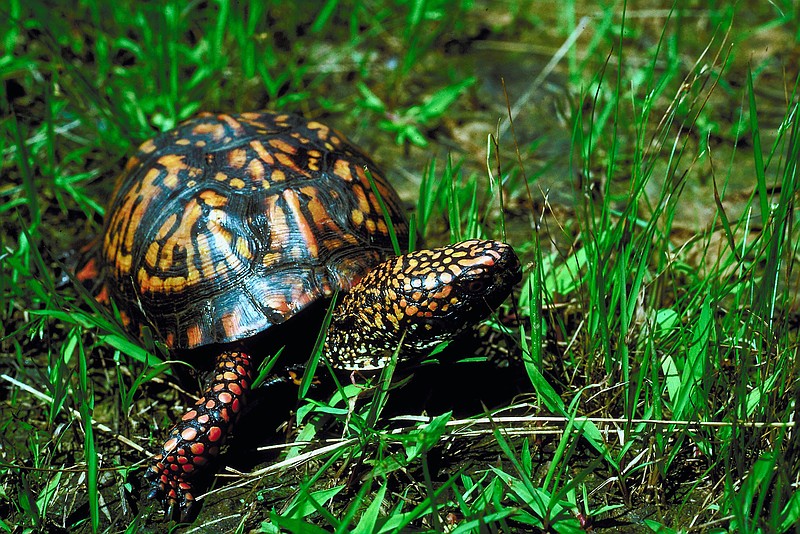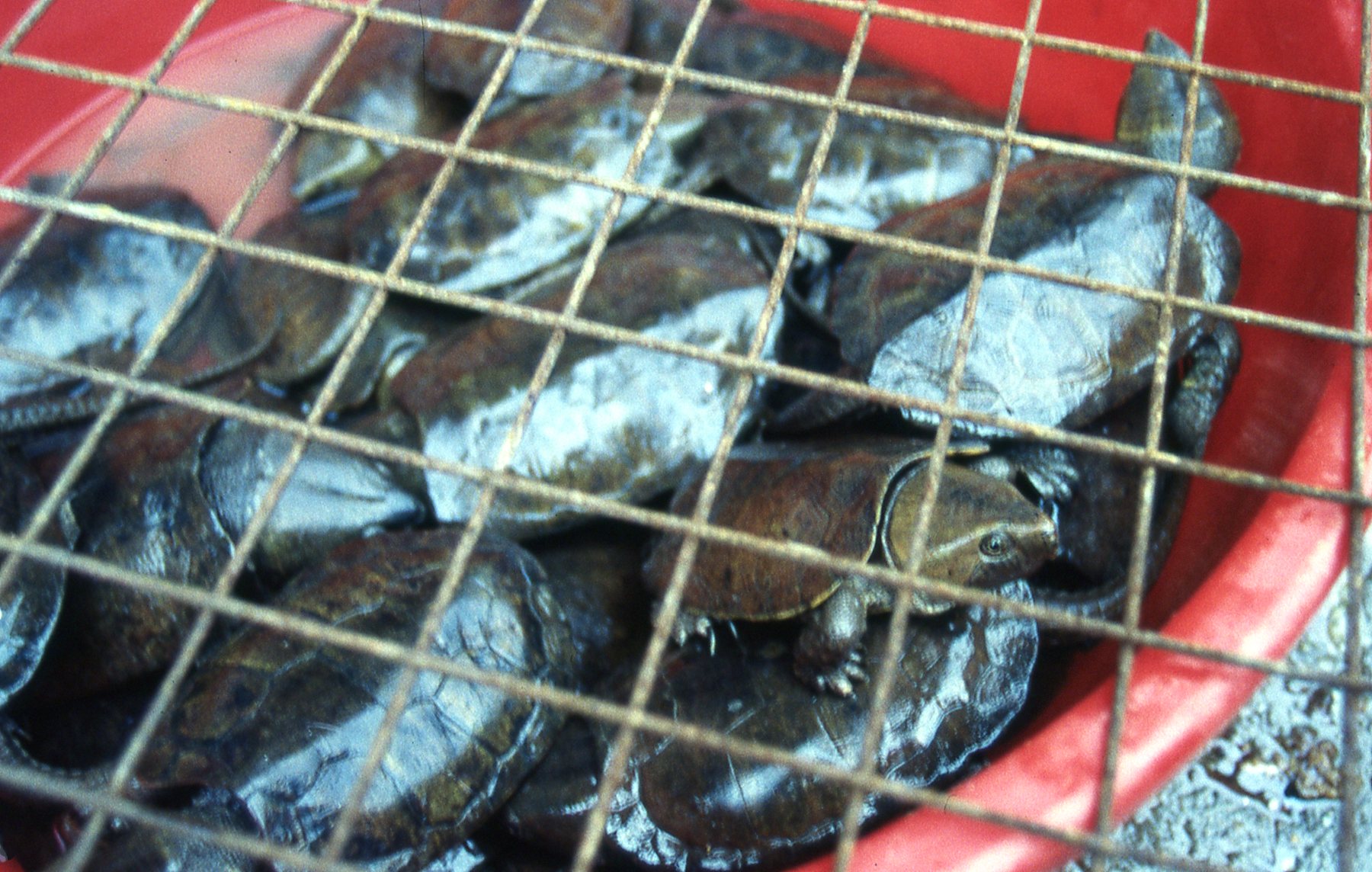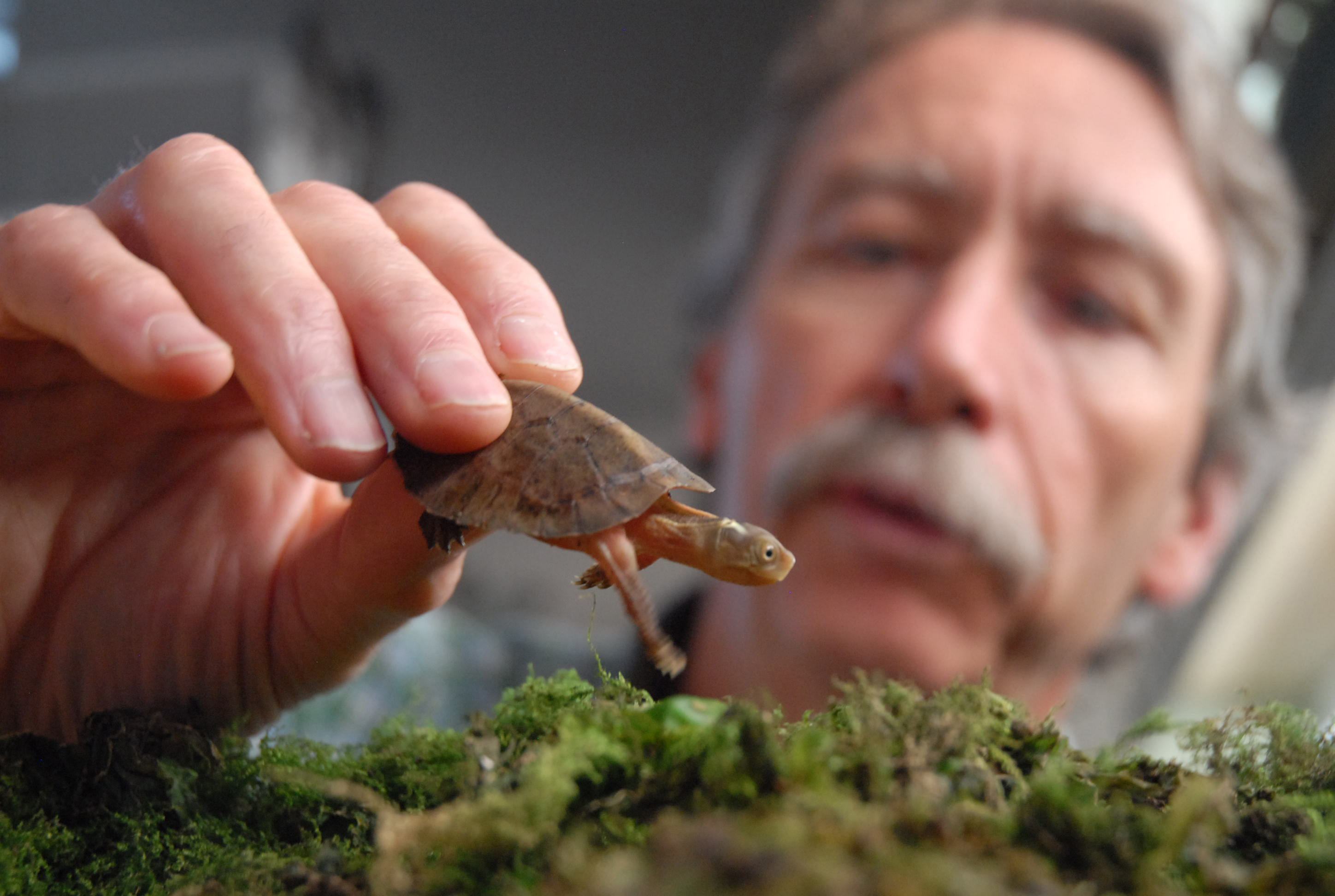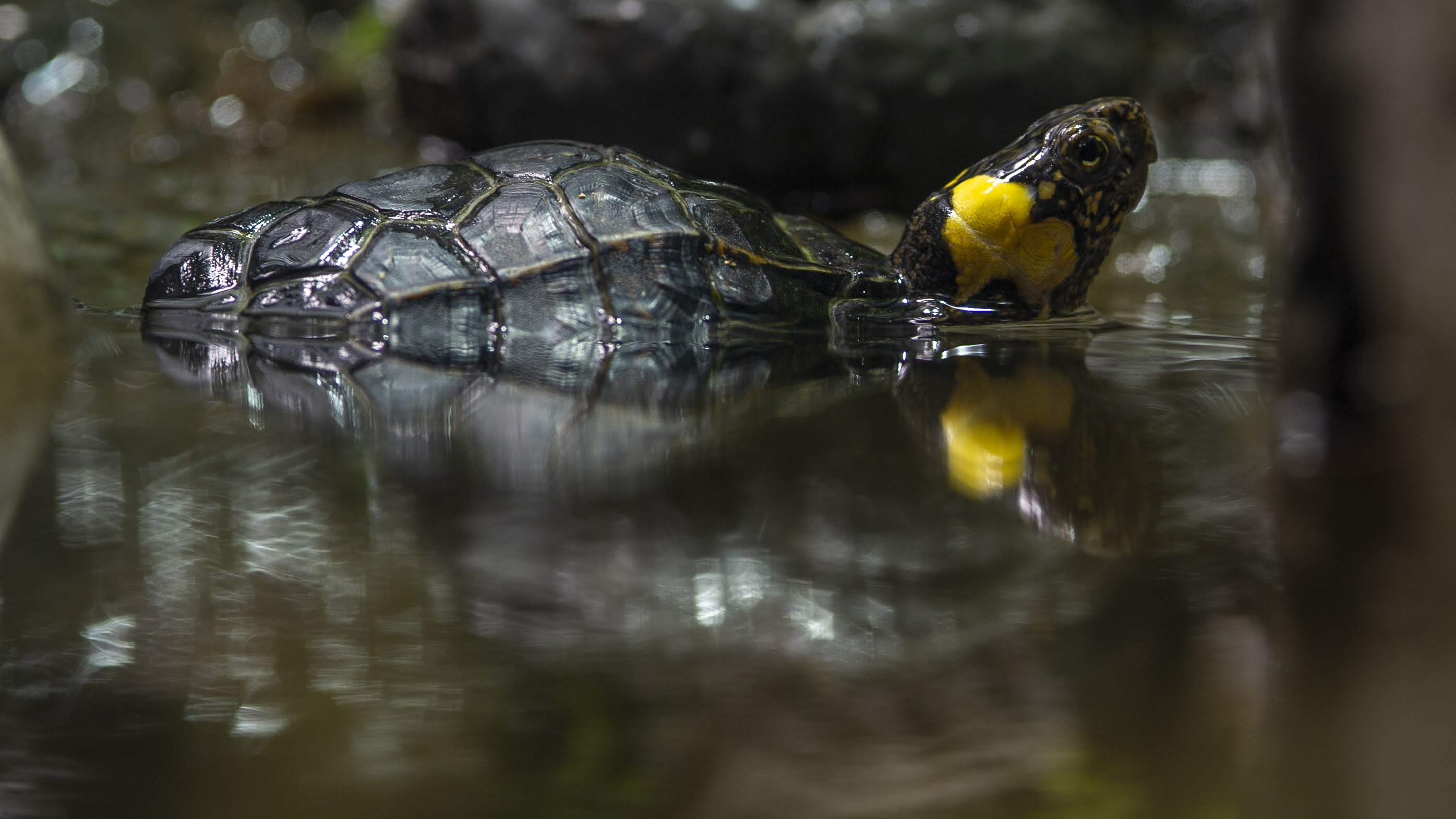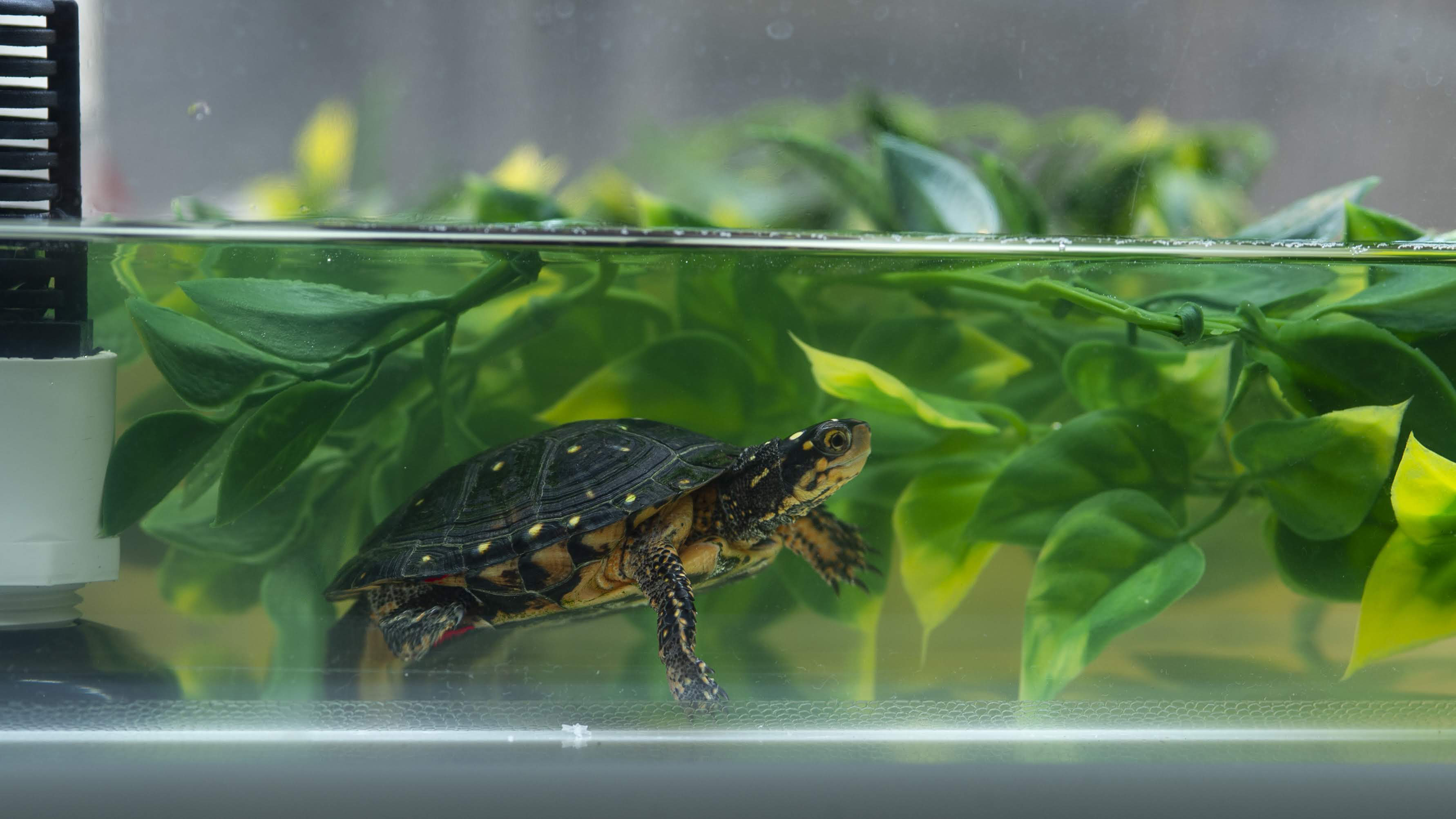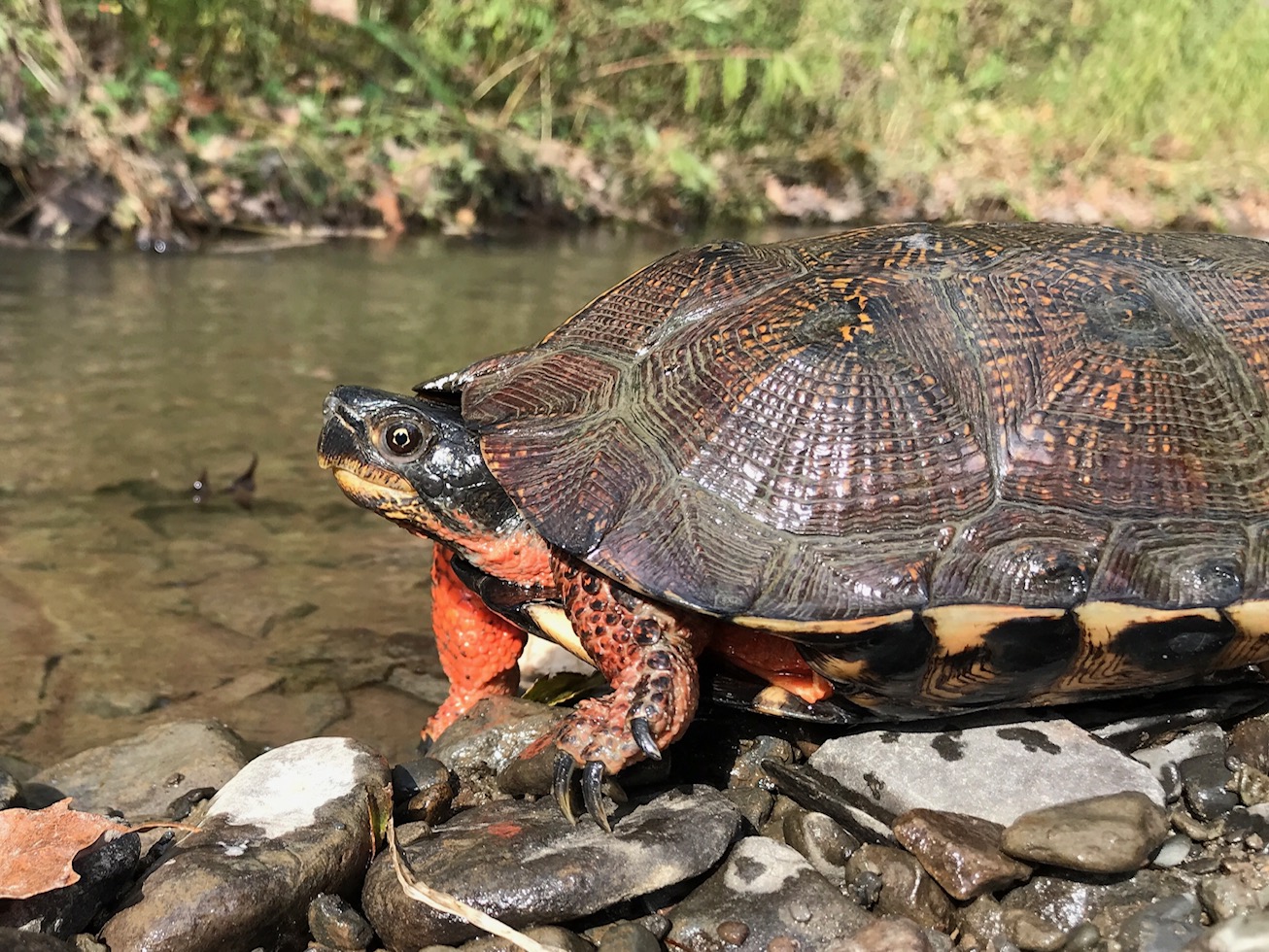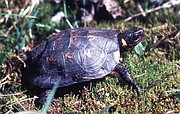A common box turtle slow-steps onto a two-lane byway, carrying the weight of its ornate shell and a bounty on its head. In recent decades, the box turtle has become one of North America's most heavily trafficked animals, poached and exported for China's high-end exotic pet market.
"What is common to us is exotic in other places," explains Dave Collins, director of forests and animal behavior at the Tennessee Aquarium who's now spearheading local efforts to combat the illegal trade of North American turtles.
For millennia, China has relied on turtles for food and in traditional medicine. But the country's relatively new exotic pet market is "dynamic. It's always changing to meet demands, so at this point, we're just trying to understand it," Collins says. "The irony and the tragedy is that as these animals become rarer, they become more valuable to those willing to trade them illegally."
And turtles have now become the most imperiled class of vertebrate in the world. In the U.S., more than 40% of native freshwater species are at risk of extinction; globally, more than 60%. Even the common box turtle, one of the most widespread North American species, is now listed as "vulnerable" by the International Union for Conservation of Nature.
So, what part has illegal poaching played in the disappearance of native turtles? How can it be stopped? And, most importantly, why does it matter?
Through a new aquarium program involving partnerships across the country, Collins hopes to answer these questions and more, while bringing awareness of the ecological crisis to the public. Here, he helps us navigate the murky waters of the black market turtle trade.
***
A brief history of the black market pet trade
After a thousand years of harvesting turtles for food and medicine, China had largely depleted its own wild turtle populations, and in the early 1990s, it began to look to American turtle farms to supplement its supply.
"Basically, that was the door opening into North America," says Collins. "The first sign of North American turtles going to China was through legal trade."
By 1997, the U.S. was annually exporting more than 8.7 million farm-raised red-eared sliders, with the largest numbers going to China each year.
All the while, China's economy was improving. In 1999, its middle class comprised 2% of the population. By 2013, it had soared to 39%, making it one of the fastest-growing in the world.
With a better standard of living and more expendable income, turtles - long ingrained in Chinese culture - became prized pets. Exotic species were considered status symbols, and the exotic pet market boomed.
"Now, [traffickers] are looking for new species to open that market up even more. And North American species, of course, are exotic in China," Collins says.
***
How the Tennessee Aquarium is keeping turtles 'SAFE'
In late February, the Tennessee Aquarium joined a growing network of zoos, aquariums, universities, government agencies and conservation nonprofits in an initiative known as Saving Animals from Extinction (SAFE). Founded in 2015 by the Association of Zoos and Aquariums, SAFE is dedicated to helping protect and recover species in need - gorillas, jaguars and whooping cranes, for example. In 2020, it formed its first program focused on American turtles, naming Collins as its program leader and coordinator.
Collins describes the program as "building a pathway from confiscation to conservation." The aquarium's SAFE program will partly function to assist federal and state wildlife law enforcement agencies in holding confiscated turtles, which must be quarantined before determining the next stage of their rehabilitation.
In October 2019, for example, more than 600 illegally collected turtles were seized from two Florida men who had planned to sell the animals on the international pet market.
"What we don't want is the U.S. Fish and Wildlife to have to spend all their time taking care of turtles. Once all their quarantine rooms are full, what do you do?" says Collins.
Currently, the local aquarium cares for about 50 confiscated turtles, though Collins says one of his priorities is to expand its capacity to hold more.
So, what happens after the animals clear quarantine? Can they be returned to the wild? And if so, where did they come from? Turtles, after all, must be returned to the regions from which they came.
"You cannot risk jeopardizing a wild population by disrupting its genetics," Collins explains.
Turtles are not federally protected. Rather, laws vary state to state, so traffickers illegally collecting turtles in one state often transport them to states which allow for their harvest.
In Tennessee, for example, regulations on the harvest of turtles are strict. Trappers must obtain one of only 35 licenses issued each year and report their catches to the Tennessee Wildlife Resources Agency.
Georgia and North Carolina protect their native species with strict bag limits; while South Carolina, which allows unregulated trapping for a number of freshwater species, is considered a haven for poachers.
In addition to lobbying to enact stricter laws, Collins hopes to develop genetic study programs that could determine the animal's home range. Another solution to handling confiscated turtles is to enter the animal into a captive-bred program. In these programs, animals that cannot be returned to the wild are bred to produce future generations of their species.
"Captive turtles can be the insurance to helping restore habitat," Collins says.
And habitat loss, he adds, is the single greatest risk to turtles.
"In our own neighborhood, we don't see nearly as many box turtles on the road as we did 20 years ago, and that's because they have been killed by those roads," says Collins. "The interest in the pet trade shouldn't obscure that fact. Development isn't going to stop. But what is lost doesn't have to be permanently lost."
***
Why the box turtle?
How did the common box turtle become America's most heavily trafficked turtle in Asia's pet trade?
The box turtle is novel for a couple of reasons. First, when frightened, it has the ability to retract its head, legs and tail inside its shell. Not all turtle species can do this. Second, its shell is ornate, patterned with orange kaleidoscope-like patterns. The most decorative individuals can be worth up to $1,000 on the black market.
Moreover, at six inches long, the box turtle is a relatively small animal. And size and color, says Collins, are two big factors in the pet trade.
While box turtles comprise the largest number in the illegal pet trade, they aren't the only vulnerable species in North America. The aquarium's SAFE program will spotlight five imperiled native species, which will be on exhibit as part of the aquarium's recently unveiled Turtles of the World gallery. In addition to the box turtle, it will include the bog turtle, spotted turtle, wood turtle and Blanding's turtle, all of which are declining in numbers.
"[These turtles] all have life histories that put them in harm's way," Collins says. "They live on both land and in water, and that time spent on land puts them at risk. They are literally competing with humans for land, and humans need a lot of land."
Bog turtle
At four inches long, the bog turtle is North America's smallest turtle species. It is also the rarest, with estimates ranging from 2,500 to 10,000 in the wild.
* Range: Scattered populations throughout the Appalachian Mountains in the eastern U.S.
* Status: Listed as federally endangered under the U.S. Endangered Species Act
Spotted turtle
In 2015, the Endangered Species Coalition named the spotted turtle one of the 10 U.S. species most threatened by habitat loss, though in some regions the pet trade has also been implicated in population declines.
* Range: Found throughout the East Coast of the U.S. and in the Great Lakes region
* Status: Listed as federally endangered in Canada; under review by the U.S. Fish and Wildlife Service for federal protection under the U.S. Endangered Species Act
Wood turtle
Each spring, the wood turtle moves from freshwater to the streambank. Known as a riparian ecosystem, this critical habitat is quickly disappearing due to agriculture, runoff and erosion.
* Range: Northeastern U.S. and the Great Lakes region
* Status: Under review by U.S. Fish and Wildlife for federal protection under the U.S. Endangered Species Act
Blanding's turtle
U.S. exports of Blanding's turtles as pets have been increasing in recent years, though the biggest threat to the species is habitat fragmentation; road-building in particular. The Blanding's is considered a highly mobile species and is particularly vulnerable to road mortality.
* Range: Found in the northern U.S. and along the Canadian border, from Nebraska to Nova Scotia
* Status: Under review by U.S. Fish and Wildlife for federal protection under the U.S. Endangered Species Act
***
The extinction crisis
According to a 2011 report issued by the Turtle Conservation Coalition, more than 40% of the world's freshwater turtles and tortoises are at risk of extinction due to habitat loss, the illegal pet trade and their use as food and in traditional medicine. Moreover, more than 60% of the world's total number of species, both freshwater and sea turtles, are imperiled - the highest percentage of any vertebrate, more than birds, mammals, fish or amphibians.
"Turtles have so much value that we don't see," Collins says. They feed on aquatic vegetation and scavenge decomposing materials, helping keep their ecosystems clean and disease-free. They maintain healthy food chains and help disperse seeds. In fact, some plant seeds, such as the mayapple, have higher rates of germination after passing through a turtle's digestive tract.
"The fate of turtles is especially tragic in light of their distinction as paragons of evolutionary success," wrote the authors of "Where Have All the Turtles Gone, and Why Does It Matter?" published in 2018 in Oxford's BioScience journal.
Turtles are more than 200 million years old, but if they're to be saved from extinction, Collins says, people must first be aware of their plight.
"Then," he says, "they just have to care."
***
Turtles by the numbers
356: Total number of turtle species in the world
61: Percent of turtle species now threatened or already extinct
89: Number of turtle species native to Asia, all of which are threatened
20 million: Number of freshwater turtles and tortoises consumed in China each year
56: Number of turtle species native to the U.S.
40: Percent of U.S. turtle species threatened with extinction
The global wildlife trade and COVID-19
As the novel coronavirus has spread across the globe, so has criticism of the global wildlife trade.In recent months, headlines across America have brought more awareness to the issues caused by animal trafficking, which not only threatens species but spreads disease.“China’s latest virus outbreak exposed perils of exotic wildlife trade,” Reuters wrote in late January. “To prevent next coronavirus, stop the wildlife trade, conservationists say,” the New York Times declared a month later.Scientists have linked the novel coronavirus to bats, and believe it originated in one of China’s open-air markets, where live animals such as snakes, turtles, porcupines, deer and more are packed together, right alongside humans.This makes it easy for viruses to jump species, which has happened before.The 2003 SARS outbreak, for example, has been linked to civets, a cat-like animal. The 2013 MERS outbreak is believed to have come from camels.“If you want to prevent epidemics that begin in animals,” wrote the author of that February New York Times story, “halt the global trade in wildlife.”
